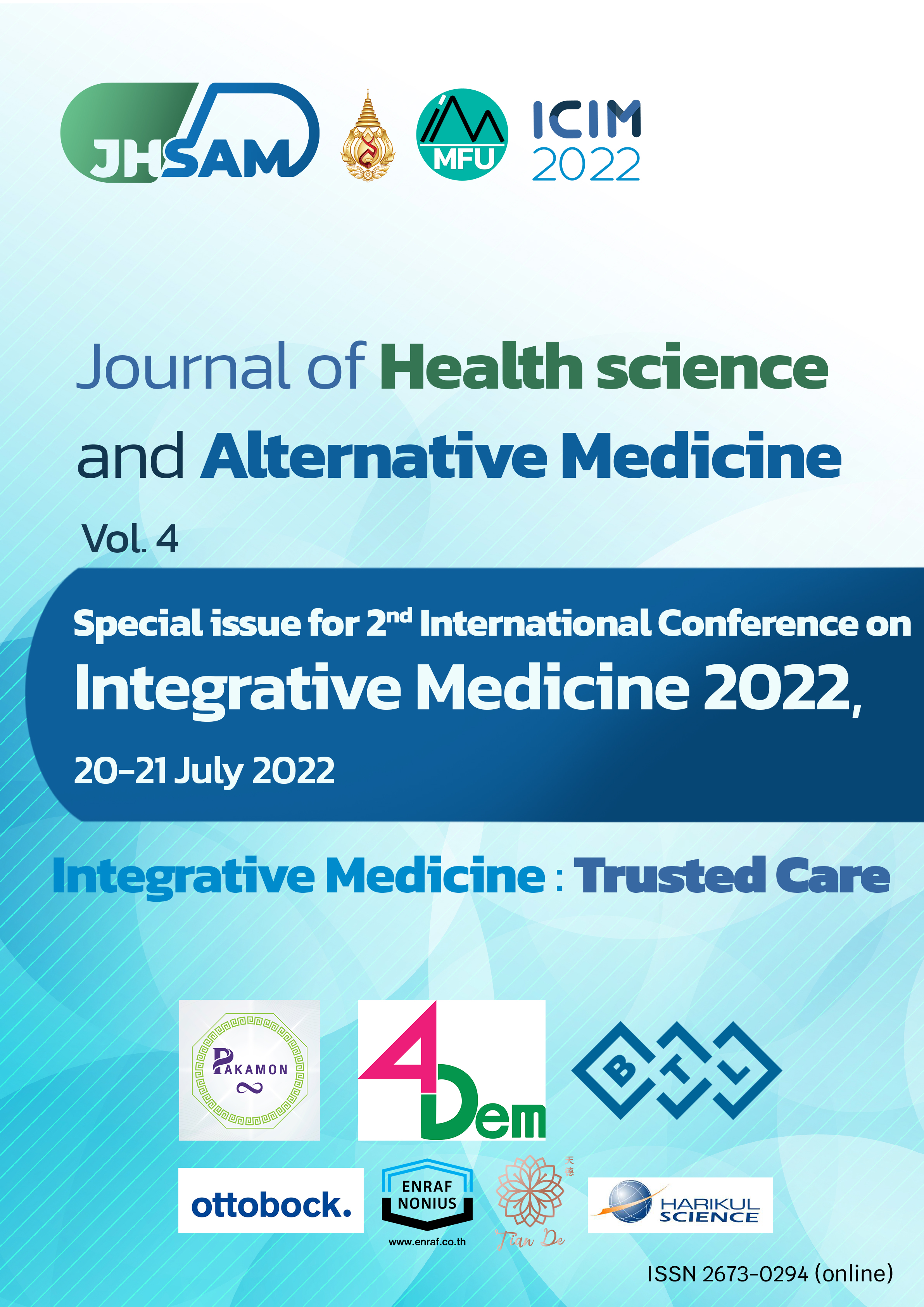C04. Case Report: Treating Atopic Dermatitis with Si-Wu-Xiao-Feng Decoction in combination with Topical Huang Qin Cream
Main Article Content
Abstract
The aim of this study is to evaluate the efficacy of treating Atopic Dermatitis with the Traditional Chinese Medicine (TCM) Formula of Si-Wu-Xiao-Feng decoction in combination with Topical Huang Qin Cream. The case report is from a 42 years old female patient presented with lesions of small blisters bilaterally spread all over her arms and legs. The blisters often become very itchy and has affected the patient for over 5 years. The blisters became more severe during the past 2 months. She is prescribed Si-Wu-Xiao-Feng decoction to drink daily 30 minutes after breakfast and dinner. The TCM herb composition of the Si-Wu-Xiao-Feng Decoction is adjusted after each follow up according to the severity and condition of the blisters. She is also prescribed a Topical Huang Qin Cream. This is an extemporaneous formulation prepared by the Institute of Thai-Chinese Medicine Mae Fah Luang University. After 6 months of treatment, the lesions of blisters, papules and scaly skin has recovered back to normal skin. After treatment was discontinued, the patient was followed up at 2 weeks and shown no eruption of blisters or signs of itchiness. Moreover, the patient liver and kidney function were measured at the 3rd month during the treatment. All parameters were within normal range. In conclusion, treating Atopic Dermatitis with the combination of Si-Wu-Xiao-Feng decoction and Topical Huang Qin Cream has shown good efficacy. It also shown potential in preventing the recurrence of the disease and is safe for the patient. This treatment regimen should be studied in a wider clinical setting for developing new treatments for Atopic Dermatitis patients in the future.
Article Details

This work is licensed under a Creative Commons Attribution-NonCommercial-NoDerivatives 4.0 International License.
JHSAM publishes all articles in full open access, meaning unlimited use and reuse of articles with appropriate credit to the authors.
All our articles are published under a Creative Commons "CC-BY-NC-ND 4.0". License which permits use, distribution and reproduction in any medium,
provided that the original work is properly cited and is used for noncommercial purposes.
References
Johansson SG, Bieber T, Dahl R,Friedmann PS, Lanier BQ, Lockey RF, et al. Revised nomenclature for allergy for global use: Report of the Nomenclature Review Committee of the World Allergy Organization, October 2003. J Allergy Clin Immunol.2004;113:832-6.
Wollenberg A, Barbarot S, Bieber T, et al. Consensus-based European guidelines for treatment of atopic eczema (atopic dermatitis) in adults and children: part I. J Eur Acad Dermatol Venereol. 2018;32:657-82.
Wollenberg A, Barbarot S, Bieber T, et al. Consensus-based European guidelines for treatment of atopic eczema (atopic dermatitis) in adults and children: part II. J Eur Acad Dermatol Venereol. 2018;32:850-78.
Wuthrich B, Schmid-Grendelmeier P. The atopic eczema/dermatitis syndrome. Epidemiology, natural course, and immunology of the IgE-associated ("extrinsic") and the nonallergic ("intrinsic") AEDS. J Investing Allergol Clin Immunol.2003;13:1-5.
Chen Hong-Feng. Zhong Yi Wai Ke Xue. 4th ed. Beijing: China Press of Traditional Chinese Medicine Cp.,Ltd.; 2016.
Zheng Xiao-Yu. Guideline for Clinical Research on New Chinese Herbal Medicine Drugs. Beijing: China Press of Traditional Chinese Medicine Co.,Ltd.; 2002.
Xi Li-hong, Jiang Yun-Ping, Wang Kun. 四物消风饮加减治疗血虚风燥型慢性湿疹临床观察. Guangming Journal of Chinese Medicine. 2019;34: 564-566.
Gong Fa-ping, Zheng Ming. 黄芩的化学成分及药理作用. Chinese Journal of Clinical Rational Drug Use. 2021;14:176-178.
Sun Peng-Yu. 从中医视角看慢性湿疹. Family & Traditional Chinese Medicine. 2014;03:48-49.
Bai Yan-ping. 湿疹的中医诊治. Chinese Journal of Dermatovenereology of Integrated Traditional and Western Medicine. 2009;08:259-261.
Wang Xin. 禤国维教授治疗慢性湿疹经验介绍. new journal of traditional Chinese medicine. 2005;37:9-10.
中华中医药学会皮肤科分会.湿疹(湿疮)中医诊疗专家共识(2016年). Chinese Journal of Dermatovenereology of Integrated Traditional and Western Medicine. 2018;17:181-183.

